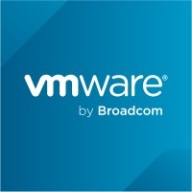

VMware Cloud Director and VMware Aria Automation compete in the cloud management solutions category. Aria Automation appears to have the upper hand with its advanced automation and integration capabilities, making it suitable for large-scale environments.
Features: VMware Cloud Director is notable for its extensive multi-tenancy support, robust security features, and comprehensive cloud services integration. Ideal for service providers, it aids in managing virtual data centers effectively. VMware Aria Automation offers robust automation capabilities, efficient orchestration, and superior integration with various platforms, providing essential flexibility for handling complex workflows.
Room for Improvement: VMware Cloud Director needs better integration with hyperscalers such as Azure or AWS, built-in billing features, and enhanced monitoring capabilities. Improved networking integration and ease of installation would be beneficial. VMware Aria Automation should simplify integration processes, especially with third-party tools, and enhance its orchestration capabilities. Its pricing strategy and complexity need refinement for a better market position.
Ease of Deployment and Customer Service: VMware Cloud Director offers various deployment options, including public and private clouds. VMware Aria Automation is mainly deployed on-premises. Customer service for both is highly rated. Still, Cloud Director users report satisfactory support due to knowledgeable staff, while Aria Automation users indicate that response times and integration support could better accommodate the needs of seamless hybrid cloud operations.
Pricing and ROI: VMware Cloud Director is considered expensive compared to alternatives, aiding in rapid provisioning and supporting complex pricing models favorable for service providers. Its ROI is significant in large setups due to provisioning efficiencies. Although costly, VMware Aria Automation justifies its expense with substantial integration and automation, offering potential long-term savings and stability. However, the high entry cost might deter smaller businesses lacking necessary technical support.
We never had major issues to report or request support.
Around 70-80% of issues can be easily troubleshot by public documentation and KB articles.
VMware Cloud Director is quite scalable; I would rate it nine out of ten.
I would rate scalability for VMware Cloud Director as 8, especially from the on-premises environment.
There are occasional problems when trying to increase the parameters of a virtual machine.
It operates for both of my products, however, as a product, it is complicated to integrate and automate with other products.
Cross-cloud migration refers to if a customer has something on Azure, wanting to bring it up on VMware or maybe from VMware to AWS, vice versa.
The console methods make management difficult until VMware tools are installed.
The pricing for VMware Cloud Director is more or less reasonable, especially when compared to Cisco, which is significantly more expensive.
From a pricing perspective, I would rate VMware Cloud Director as 7 because being the available feature set, Broadcom always offered more price compared to another product.
It helps us automate the workflow of creating many VMs and the TensorFlow key method.
We have strong regulations for maintaining compliance and mitigating risks with this product.
A notable feature is the Independent Disk, which allows detaching a virtual drive from one virtual machine and attaching it to another, enabling more flexibility in operations.
The most valuable feature of VMware Cloud Director is segregating the underlying infrastructure for the end user.
| Product | Market Share (%) |
|---|---|
| VMware Aria Automation | 9.4% |
| VMware Cloud Director | 4.9% |
| Other | 85.7% |


| Company Size | Count |
|---|---|
| Small Business | 32 |
| Midsize Enterprise | 24 |
| Large Enterprise | 130 |
| Company Size | Count |
|---|---|
| Small Business | 24 |
| Midsize Enterprise | 11 |
| Large Enterprise | 36 |
VMware Aria Automation is a cloud management tool that allows companies to simplify their cloud experience through a modern automation platform. The solution is designed to deliver self-service clouds, multi-cloud automation with governance, and DevOps-based security and infrastructure management. It helps organizations improve IT agility, efficiency, and productivity through its various features.
VMware Aria Automation has multiple use cases that include the following:
VMware Aria Automation Features
VMware Aria Automation has various features that allow users to easily perform operations. Some of the solution's capacities include:
VMware Aria Automation Benefits
VMware Aria Automation offers its users various benefits. Some of the biggest advantages that the solution brings to companies that utilize it include:
Reviews from Real Users
Awais J., CTO/CEO at a tech services company, likes VMware Aria Automation because it saves a lot of time, provides more visibility, and has extensive automation capabilities.
An IT consultant at a government rates VMware Aria Automation highly because the product gives you flexibility to analyze and consume resources.
VMware Cloud Director, also known as vCloud Director, is a cloud management tool that offers secure, flexible, and efficient cloud resources to thousands of enterprises and IT teams across the world. The solution serves as one of the leading cloud service-delivery platforms for businesses that want to manage and operate their services effectively. By deploying this solution, companies can benefit from virtualized networking, computing, security, and storage. These benefits can be received in a timely manner, as the infrastructure of the product is operationally ready within minutes and clients do not need to install and configure physical infrastructure.
One of the biggest advantages of vCloud Director is that it allows users to build cloud-ready applications. In several ways, it facilitates the process for developers, including:
vCloud Director Features
This VMware product has various features through which users can virtualize their data and benefit from quality management solutions. Among the popular capabilities of vCloud Director are:
vCloud Director Benefits
VMware vCloud Director offers various benefits to its users. Some of these include:
Reviews from Real Users
Ajit Y., a cloud architect at a computer software company, likes VMware vCloud Director because it is a stable, truly multitenant software and the go-to tool for infrastructure as a service.
Kashif F., a divisional engineer at National Telecom Corporatio, rates vCloud Director highly because the product can be used for infrastructure provisioning without using a platform service.
We monitor all Cloud Management reviews to prevent fraudulent reviews and keep review quality high. We do not post reviews by company employees or direct competitors. We validate each review for authenticity via cross-reference with LinkedIn, and personal follow-up with the reviewer when necessary.